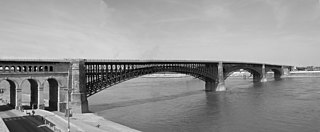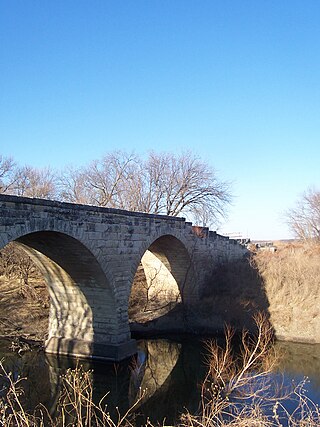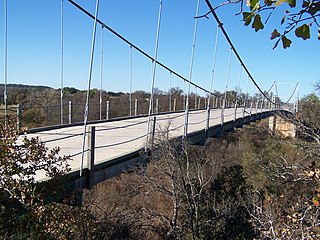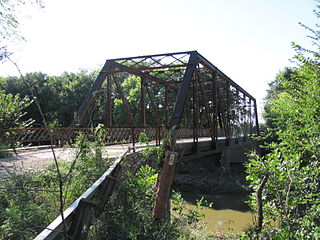Luten Bridge Company and variations such as Luten Engineering Company was the name of a number of different bridge building companies in the United States during the early- to mid-20th century. Each had rights to build concrete Luten arch bridges, according to the patented designs of Daniel B. Luten, of Indianapolis.
The Kansas City Bridge Company was a bridge building company that built many bridges throughout the Midwest United States in the early 1900s. The company was founded in 1893 and ceased business around 1960.

The Phoenix Iron Works, located in Phoenixville, Pennsylvania, was a manufacturer of iron and related products during the 19th century and early 20th century. Phoenix Iron Company was a major producer of cannon for the Union Army during the American Civil War. The company also produced the Phoenix column, an advance in construction material. Company facilities are a core component of the Phoenixville Historic District, a National Register of Historic Places site that was in 2006 recognized as a historic landmark by ASM International.

The King Iron Bridge & Manufacturing Company was a late-19th-century bridge building company located in Cleveland, Ohio. It was founded by Zenas King (1818–1892) in 1858 and subsequently managed by his sons, James A. King and Harry W. King and then his grandson, Norman C. King, until the mid-1920s. Many of the bridges built by the company were used during America's expansion west in the late 19th century and early 20th century, and some of these bridges are still standing today.

The Western Bridge and Construction Company, located in Omaha, Nebraska, was one of the foremost bridge engineering and manufacturing companies in the Midwestern United States. Several of their bridges are now listed on the National Register of Historic Places. Their headquarters were located in the Bee Building in Downtown Omaha.

Chevelon Creek Bridge is a historic road bridge located about 12 miles (19 km) southeast of Winslow, in Navajo County, eastern Arizona, United States. It is a steel Warren Pony truss bridge over Chevelon Creek, built on the first permanent road connecting Holbrook, the seat of Navajo County, and Winslow. When built, the road was regionally important in northern Arizona as well as being a segment of an early national highway at the time automobile traffic was growing and national roads were first being formed. The bridge was listed on the National Register of Historic Places in 1983 for being a rare design in Arizona, part of an early transnational roadway, one of the first bridges built by Arizona after statehood in 1912, and being in nearly original condition.

The Keystone Bridge Company, founded in 1865 by Andrew Carnegie, was an American bridge building company. It was one of the 28 companies absorbed into the American Bridge Company in 1900. The company advertised its services for building steel, wrought iron, wooden railway and road bridges. It held a patent for wrought iron bridges and also supplied wrought iron columns for buildings. Thomas Carnegie worked for Keystone Bridge as treasurer for roughly 20 years, from the founding of the company until his death in 1886.

Canton Bridge Company was a firm that was later incorporated into the American Bridge Company. The firm was established in Canton, Ohio in 1892 and became one of the nation's biggest bridge-builders during the early 20th century. It designed and/or built many bridges that later became listed on the U.S. National Register of Historic Places (NRHP).

The Pueblo Bridge Co. is a firm that built a large number of bridges in the United States. Several are listed on the U.S. National Register of Historic Places.
Topeka Bridge & Iron Co. was a bridge company. Its works include many bridges that are now listed on the U.S. National Register of Historic Places. Its Canyon Diablo Bridge was a concrete Luten arch bridge built in 1914. Its Amelia Park Bridge, for another example, was built in 1914.
Fargo Bridge & Iron Co. was a bridge company based in North Dakota in the early part of the 20th century.

The Midland Bridge Company is a firm based in Kansas City, Missouri, United States, that has built numerous bridges. Several of its works are listed on the U.S. National Register of Historic Places (NRHP).

George Herndon Pegram (1855–1937), most commonly known as George H. Pegram, was an engineer who patented the Pegram truss.

Cottonwood River is one of the principal tributaries of the Neosho River in central Kansas of the United States.

Monarch Engineering Co. was an American firm of Denver, Colorado, active in engineering and construction services. John A. Crook and his brother, Guy A. Crook of Falls City, were founders of the Monarch Engineering company which had its origin and main offices at Falls City, with offices in Kansas City, and Denver. Under the management of these men the Monarch Engineering company had risen to become an important and prosperous concern and a vast amount of bridge construction, city paving, irrigation-dam building, and public building work has been done under their supervision. Within ten years after the firm had been in operation, or since 1908, its activities constantly increased and in 1917 they purchased the Denver Steel and Iron Works in order to facilitate the material supply part of the construction work in which they were engaged.

The Virginia Bridge & Iron Co., also known as Virginia Bridge Company, was a bridge company based in Roanoke, Virginia.

Austin Bridge Company was a bridge company based in Dallas, Texas. It fabricated and built a number of bridges that are listed on the U.S. National Register of Historic Places. It eventually became part of Austin Industries.

The Kansas and Missouri Bridge was an iron truss bridge across the Missouri River at Fort Leavenworth. The bridge opened in 1872 and closed permanently in 1955.

The Terminal Bridge was a pontoon bridge and then a through-truss swing bridge at Leavenworth, Kansas. The pontoon bridge opened in 1889. The steel truss bridge opened on January 2, 1894, and was demolished in 1987.

The Cottonwood River Pratt Truss Bridge is a historic bridge which carries Main Street across the Cottonwood River in Cedar Point, Kansas, USA. The single-span Pratt truss bridge was built in 1916 by the Missouri Valley Bridge and Iron Company. Locals proposed a bridge along a western extension of Main Street in 1914, but construction did not begin until late 1915 due to negotiations over its price; the county initially received no bids for the bridge after underestimating its cost, and it rejected every bid in the second round until the Missouri Valley Company dropped theirs to $8,750. The bridge is 142 feet (43 m) long, 17 feet (5.2 m) wide and is 32.5 feet (9.9 m) above the river. The Pratt truss design, with vertical and center-facing diagonal beams, was commonly used at the time due to its stability. The Cottonwood River bridge is one of roughly 800 examples of the type in Kansas.

















